Anti-Mycobacterium tuberculosis Activity of Esters of Quinoxaline 1,4-Di-N-Oxide
Abstract
1. Introduction
2. Results and Discussion
2.1. Biological Activity
2.2. Inhibitory Assay
2.3. Stability Analysis by UPLC-MS
3. Materials and Methods
3.1. Chemical Synthesis
3.2. Antitubercular Assays
3.3. Selectivity Index
3.4. Enzymatic Assay
3.4.1. Assay Set Up
3.4.2. M. tuberculosis Gyrase Supercoiling
3.4.3. Data Acquisition and Analysis
3.5. Chromatographic Analysis
4. Conclusions
Author Contributions
Funding
Acknowledgments
Conflicts of Interest
References
- World Health Organization. Tuberculosis. 2014. Available online: http://www.who.int/topics/tuberculosis/en/ (accessed on 1 May 2015).
- Falzon, D.; Mirzayev, F.; Wares, F.; Baena, I.G.; Zignol, M.; Linh, N.; Weyer, K.; Jaramillo, E.; Floyd, K.; Raviglione, M. Multidrug-resistant tuberculosis around the world: What progress has been made? Eur. Respir. J. 2015, 45, 150–160. [Google Scholar] [CrossRef] [PubMed]
- Oyewale, O.A. Present status of quinoxaline motifs: Excellent pathfinders in therapeutic medicine. Eur. J. Med. Chem. 2014, 85, 688–715. [Google Scholar]
- Carta, A.; Paglietti, G.; Rahbar Nikookar, M.E.; Sanna, P.; Sechi, L.; Zanetti, S. Novel substituted quinoxaline 1,4-dioxides with in vitro antimycobacterial and anticandida activity. Eur. J. Med. Chem. 2002, 37, 355–366. [Google Scholar] [CrossRef]
- Ortega, M.A.; Montoya, M.E.; Jaso, A.; Zarranz, B.; Tirapu, I.; Aldana, I.; Monge, A. Antimycobacterial activity of new quinoxaline-2-carbonitrile and quinoxaline-2-carbonitrile 1,4-di-N-oxide derivatives. Pharmazie 2001, 56, 205–207. [Google Scholar] [CrossRef] [PubMed]
- Villar, R.; Vicente, E.; Solano, B.; Pérez-Silanes, S.; Aldana, I.; Maddry, J.A.; Lenaerts, A.J.; Franzblau, S.G.; Cho, S.H.; Monge, A.; et al. In vitro and in vivo antimycobacterial activities of ketone and amide derivatives of quinoxaline 1,4-di-N-oxide. J. Antimicrob. Chemother. 2008, 62, 547–554. [Google Scholar] [CrossRef] [PubMed]
- Vicente, E.; Pérez-Silanes, S.; Lima, L.M.; Ancizu, S.; Burguete, A.; Solano, B.; Villar, R.; Aldana, I.; Monge, A. Selective activity against Mycobacterium tuberculosis of new quinoxaline 1,4-di-N-oxides. Bioorg. Med. Chem. 2009, 17, 385–389. [Google Scholar] [CrossRef] [PubMed]
- Jaso, A.; Zarranz, B.; Aldana, I.; Monge, A. Synthesis of new 2-acetyl and 2-benzoyl quinoxaline 1,4-di-N-oxide derivatives as anti-Mycobacterium tuberculosis agents. Eur. J. Med. Chem. 2003, 38, 791–800. [Google Scholar] [CrossRef]
- Vicente, E.; Villar, R.; Burguete, A.; Solano, B.; Pérez-Silanes, S.; Aldana, I.; Maddry, J.A.; Lenaerts, A.J.; Franzblau, S.G.; Cho, S.H.; et al. Efficacy of quinoxaline-2-carboxylate 1,4-di-N-oxide derivatives in experimental tuberculosis. Antimicrob. Agents Chemother. 2008, 52, 3321–3326. [Google Scholar] [CrossRef] [PubMed]
- Pan, Y.; Li, P.; Xie, S.; Tao, Y.; Chen, D.; Dai, M.; Hao, H.; Huang, L.; Wang, Y.; Wang, L.; et al. Synthesis, 3D-QSAR analysis and biological evaluation of quinoxaline 1,4-di-N-oxide derivatives as antituberculosis agents. Bioorg. Med. Chem. Lett. 2016, 26, 4146–4153. [Google Scholar] [CrossRef] [PubMed]
- Torres, E.; Moreno, E.; Ancizu, S.; Barea, C.; Galiano, S.; Aldana, I.; Monge, A.; Pérez-Silanes, S. New 1,4-di-N-oxide-quinoxaline-2-ylmethylene isonicotinic acid hydrazide derivatives as anti-Mycobacterium tuberculosis agents. Bioorg. Med. Chem. Lett. 2011, 21, 3699–3703. [Google Scholar] [CrossRef] [PubMed]
- Ramalingam, P.; Ganapaty, S.; Rao, C.B. In vitro antitubercular and antimicrobial activities of 1-substituted quinoxaline-2,3(1H,4H)-diones. Bioorg. Med. Chem. Lett. 2010, 20, 406–408. [Google Scholar] [CrossRef] [PubMed]
- Kumar, K.S.; Rambabu, D.; Sandra, S.; Kapavarapu, R.; Krishna, G.R.; Basaveswara Rao, M.V.; Chatti, K.; Reddy, C.M.; Misra, P.; Pal, M. AlCl3 induced (hetero)arylation of 2,3-dichloroquinoxaline: A one-pot synthesis of mono/disubstituted quinoxalines as potential antitubercular agents. Bioorg. Med. Chem. 2012, 20, 1711–1722. [Google Scholar] [CrossRef] [PubMed]
- Radwan, A.A.; Abdel-Mageed, W.M. In silico studies of quinoxaline-2-carboxamide 1,4-di-N-oxide derivatives as antimycobacterial agents. Molecules 2014, 19, 2247–2260. [Google Scholar] [CrossRef] [PubMed]
- Xu, Y.; Wu, F.; Yao, Z.; Zhang, M.; Jiang, S. Synthesis of quinoxaline 1,4-di-N-oxide analogues and crystal structure of 2-carbomethoxy-3-hydroxyquinoxaline-di-N-oxide. Molecules 2011, 16, 6894–6901. [Google Scholar] [CrossRef] [PubMed]
- Dos Santos Fernandes, G.F.; de Souza, P.C.; Moreno-Viguri, E.; Santivañez-Veliz, M.; Paucar, R.; Pérez-Silanes, S.; Chegaev, K.; Guglielmo, S.; Lazzarato, L.; Fruttero, R.; et al. Design, Synthesis, and Characterization of N-Oxide-Containing Heterocycles with in Vivo Sterilizing Antitubercular Activity. J. Med. Chem. 2017, 60, 8647–8660. [Google Scholar] [CrossRef] [PubMed]
- Blower, T.R.; Williamson, B.H.; Kerns, R.J.; Berger, J.M. Crystal Structure and Stability of Gyrase-Fluoroquinolone Cleaved Complexes from Mycobacterium Tuberculosis. Proc. Natl. Acad. Sci. USA 2016, 113, 1706–1713. [Google Scholar] [CrossRef] [PubMed]
- Peraman, R.; Kuppusamy, R.; Killi, S.K.; Reddy, Y.P. New Conjugates of Quinoxaline as Potent Antitubercular and Antibacterial Agents. Research article. Int. J. Med. Chem. 2016, 2016, 6471352. [Google Scholar] [CrossRef] [PubMed]
- Boyd, G.W.; Coombs, M.M.; Baird, W.M. The presence of a trifluoromethyl rather than a methyl substituent in the bay-region greatly decreases the DNA-binding and tumour-initiating activity of the cyclopenta[α]phenanthren-17-ones. Carcinogenesis 1995, 16, 2543–2547. [Google Scholar] [CrossRef] [PubMed]
- Gómez-Caro, L.C.; Sánchez-Sánchez, M.; Bocanegra-García, V.; Rivera, G.; Monge, A. Synthesis of quinoxaline 1,4-di-N-oxide derivatives on solid support using room temperature and microwave-assisted solvent-free procedures. Química Nova 2011, 34, 1147–1151. [Google Scholar] [CrossRef]
- Duque-Montaño, B.E.; Gómez-Caro, L.C.; Sanchez-Sanchez, M.; Monge, A.; Hernández-Baltazar, E.; Rivera, G.; Torres-Angeles, O. Synthesis and in vitro evaluation of new ethyl and methyl quinoxaline-7-carboxylate 1,4-di-N-oxide against Entamoeba histolytica. Bioorg. Med. Chem. 2013, 21, 4550–4558. [Google Scholar] [CrossRef] [PubMed]
- Villalobos-Rocha, J.C.; Sánchez-Torres, L.; Nogueda-Torres, B.; Segura-Cabrera, A.; García-Pérez, C.A.; Bocanegra-García, V.; Palos, I.; Monge, A.; Rivera, G. Anti-Trypanosoma cruzi and anti-leishmanial activity by quinoxaline-7-carboxylate 1,4-di-N-oxide derivatives. Parasitol. Res. 2014, 113, 2027–2035. [Google Scholar] [CrossRef] [PubMed]
- Rivera, G.; Andrade-Ochoa, S.; Romero, M.S.O.; Palos, I.; Monge, A.; Sanchez-Torres, L.E. Ester of Quinoxaline-7-carboxylate 1,4-di-N-oxide as Apoptosis Inductors in K-562 Cell Line: An in vitro, QSAR and DFT Study. Anticancer Agents Med. Chem. 2017, 17, 682–691. [Google Scholar] [CrossRef] [PubMed]
- Chacón-Vargas, K.F.; Nogueda-Torres, B.; Sánchez-Torres, L.E.; Suarez-Contreras, E.; Villalobos-Rocha, J.C.; Torres-Martinez, Y.; Lara-Ramirez, E.E.; Fiorani, G.; Krauth-Siegel, R.L.; Bolognesi, M.L.; et al. Trypanocidal Activity of Quinoxaline 1,4 Di-N-oxide Derivatives as Trypanothione Reductase Inhibitors. Molecules 2017, 22, 220. [Google Scholar] [CrossRef] [PubMed]
- Franzblau, S.G.; Witzig, R.S.; McLaughlin, J.C.; Torres, P.; Madico, G.; Hernandez, A.; Degnan, M.T.; Cook, M.B.; Quenzer, V.K.; Ferguson, R.M.; et al. Rapid, low-technology MIC determination with clinical Mycobacterium tuberculosis isolates by using the microplate Alamar Blue assay. J. Clin. Microbiol. 1998, 36, 362–366. [Google Scholar] [PubMed]
- Cho, S.H.; Warit, S.; Wan, B.; Hwang, C.H.; Pauli, G.F.; Franzblau, S.G. Low-Oxygen-Recovery Assay for High-Throughput Screening of Compounds against Nonreplicating Mycobacterium tuberculosis. Antimicrob. Agents Chemother. 2007, 51, 1380–1385. [Google Scholar] [CrossRef] [PubMed]
- Luna-Herrera, J.; Martínez-Cabrera, G.; Parra-Maldonado, R.; Enciso-Moreno, J.A.; Torres-López, J.; Quesada-Pascual, F.; Delgadillo-Polanco, R.; Franzblau, S.G. Use of receiver operating characteristic curves to assess the performance of a microdilution assay for determination of drug susceptibility of clinical isolates of Mycobacterium tuberculosis. Eur. J. Clin. Microbiol. Infect. Dis. 2003, 22, 21–27. [Google Scholar] [PubMed]
- Nguta, J.M.; Appiah-Opong, R.; Nyarko, A.K.; Yeboah-Manu, D.; Addo, P.G. Current perspectives in drug discovery against tuberculosis from natural products. Int. J. Mycobacteriol. 2015, 4, 165–183. [Google Scholar] [CrossRef] [PubMed]
Sample Availability: Samples of the all compounds are available from the authors. |

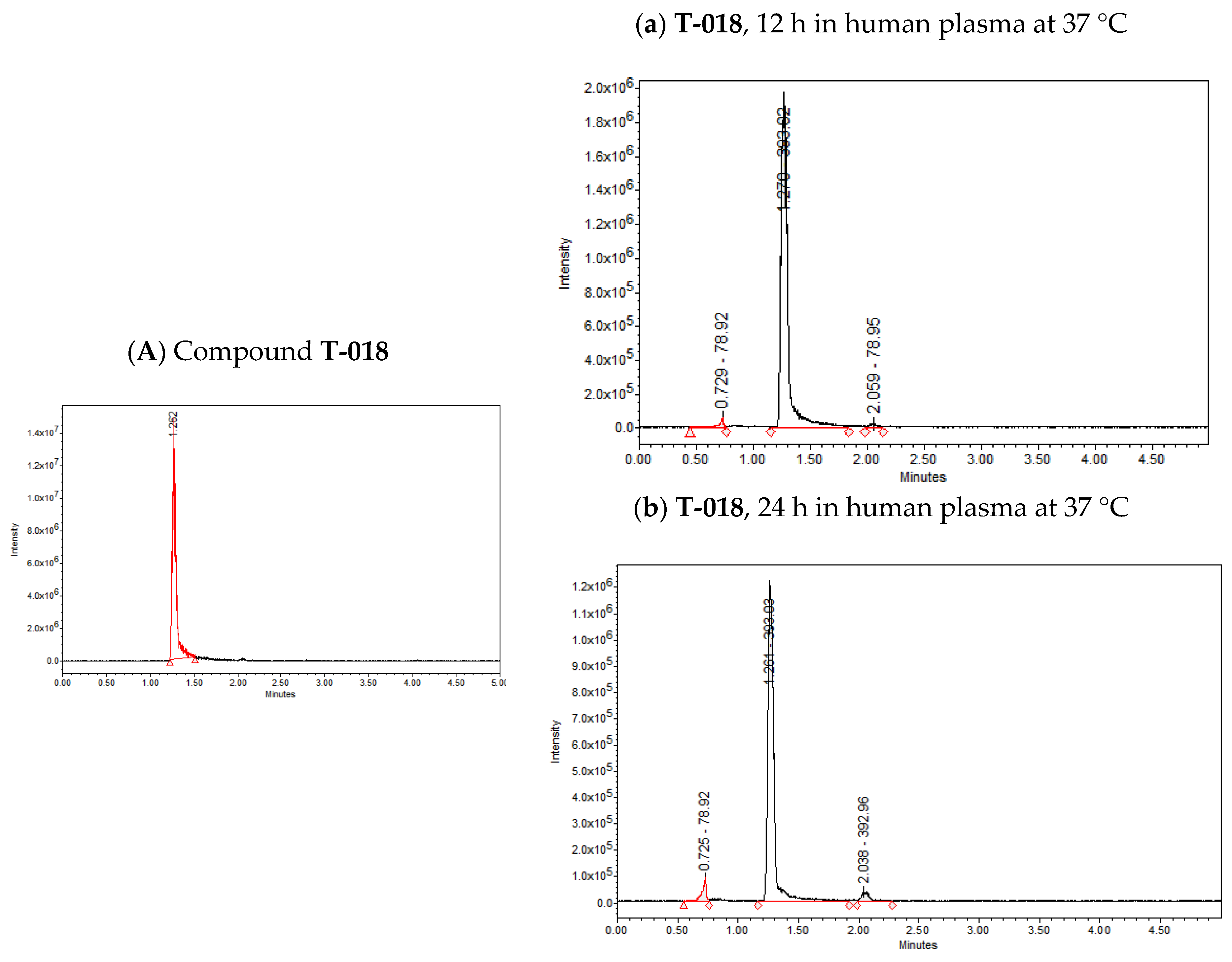
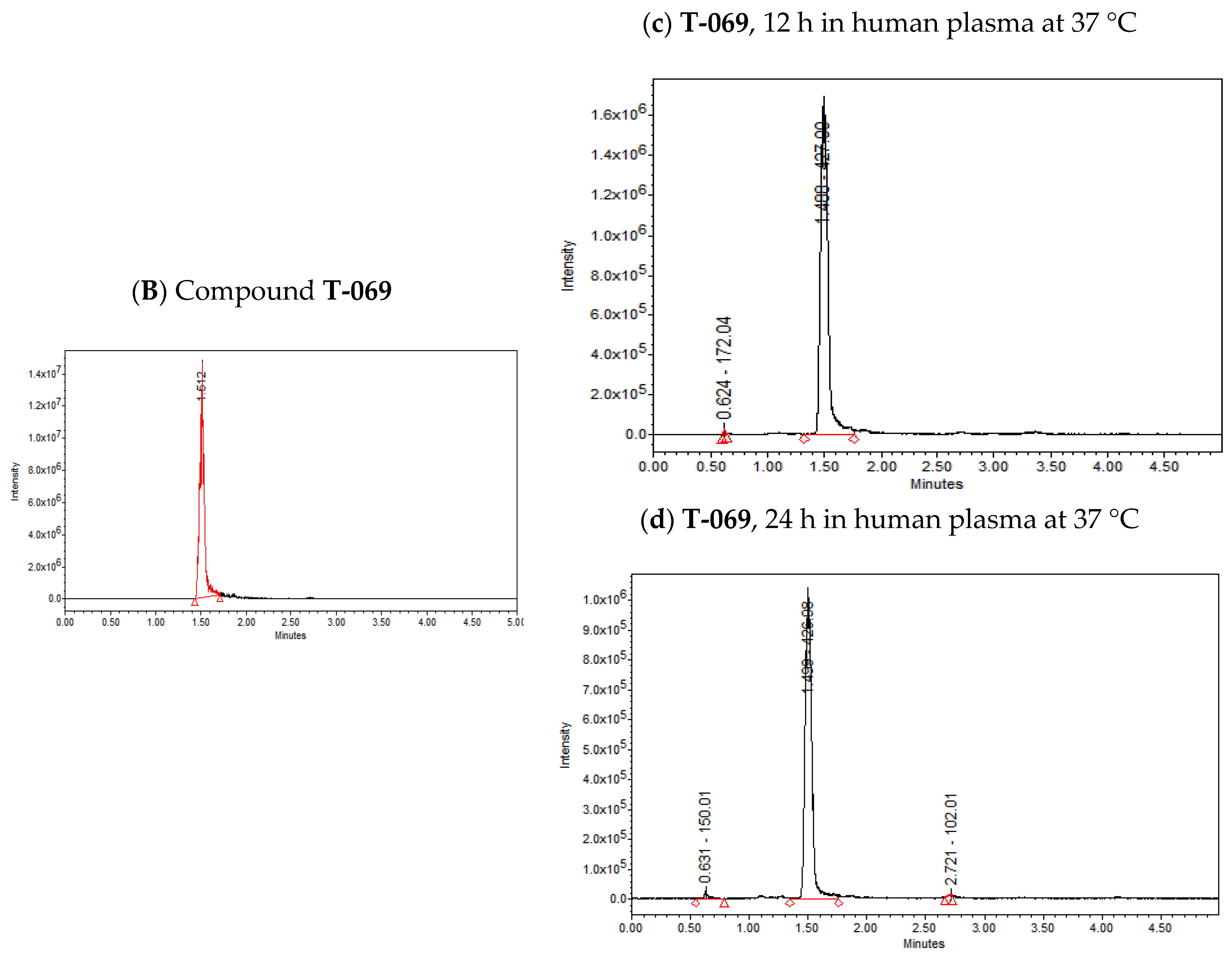
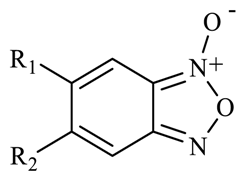
| Code | R1 | R2 | MABA MIC (µg/mL) | LORA MIC (µg/mL) |
|---|---|---|---|---|
| T-014 | CH3OOC | H | 7.6 | 12.98 |
| T-036 | CH3OOC | CH3O | >128 | ND |
| T-046 | H | H | 58.5 | 46.97 |
| T-063 | (CH3)2CHOOC | H | 1.4 | 3.04 |
| T-074 | CH3CH2CH2OOC | H | 0.87 | 4.62 |
| RMP | 0.03 | 0.89 | ||
| INH | 0.12 | >128 | ||
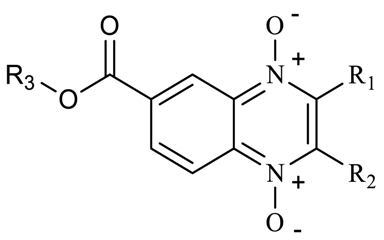
| Code | R1 | R2 | R3 | MABA MIC (µg/mL) | LORA MIC (µg/mL) |
|---|---|---|---|---|---|
| T-003 | COC6H5 | CH3 | CH3 | 3.47 | 1.49 |
| T-004 | CO-phenyl | CH3 | CH3CH2 | 2.32 | 0.61 |
| T-006 | COCH3 | CF3 | CH3CH2 | 0.29 | 0.42 |
| T-007 | CO-napthyl | CF3 | CH3CH2 | 0.14 | 0.43 |
| T-011 | CO-thienyl | CF3 | CH3CH2 | 0.10 | 0.21 |
| T-012 | CONHC6H5 | CH3 | CH3 | 1.07 | 0.86 |
| T-013 | COOCH2CH3 | CH3 | CH3 | 0.47 | 0.54 |
| T-015 | COOCH2CH3 | CH3 | CH3CH2 | 0.50 | 0.49 |
| T-018 | CO-phenyl | CF3 | CH3 | 0.15 | 0.34 |
| T-022 | COOCH3 | CH3 | CH3 | 0.29 | 0.56 |
| T-026 | COCH2CH3 | CF3 | CH3CH2 | 22.5 | 2.5 |
| T-034 | COCH3 | CH3 | CH3 | 1.1 | 0.7 |
| T-037 | COOCH2CH3 | CH2COOCH2CH3 | CH3 | 1.2 | 1.9 |
| T-038 | COCH2CH3 | CF3 | CH3 | <0.4 | ND |
| T-039 | COCH(CH3)2 | CF3 | CH3 | 1.54 | 0.83 |
| T-042 | COOCH2CH3 | C6H5 | CH3 | 1.0 | 0.5 |
| T-043 | COOCH2CH3 | C6H5 | CH3CH2 | 0.54 | 0.47 |
| T-045 | CONH2 | CH3 | CH3CH2 | 29.83 | 100.29 |
| RMP | 0.03 | 0.89 | |||
| INH | 0.12 | >128 | |||
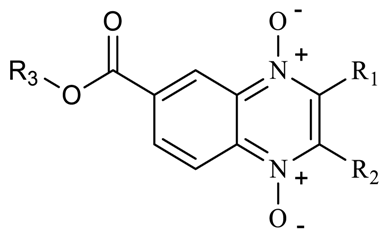
| Code | R1 | R2 | R3 | MABA MIC (µg/mL) | LORA MIC (µg/mL) |
|---|---|---|---|---|---|
| T-064 | COOCH3 | CH3 | (CH3)2CH | 0.58 | 0.56 |
| T-065 | COOCH2CH3 | CH3 | (CH3)2CH | 0.7 | 0.5 |
| T-066 | COOC(CH3)3 | CH3 | (CH3)2CH | 68.6 | >100 (77%) |
| T-067 | COOCH2CH3 | CH2COOCH2CH3 | (CH3)2CH | 3.41 | 2.47 |
| T-069 | CO-thienyl | CF3 | (CH3)2CH | 0.08 | 0.23 |
| T-070 | COCH3 | CF3 | (CH3)2CH | 0.14 | 0.24 |
| T-071 | CO-phenyl | CF3 | (CH3)2CH | 1.19 | 0.64 |
| T-072 | CO-napthyl | CF3 | (CH3)2CH | 0.15 | 0.51 |
| T-073 | CO-furyl | CF3 | (CH3)2CH | 0.7 | 0.6 |
| T-084 | COCH3 | CH3 | (CH3)2CH | 0.8 | 0.6 |
| T-085 | COCH(CH3)2 | CF3 | (CH3)2CH | 0.13 | 0.13 |
| T-088 | COOCH3 | CH3 | CH3CH2CH2 | 0.14 | 0.27 |
| T-089 | CO-thienyl | CF3 | CH3CH2CH2 | 0.12 | 0.15 |
| T-090 | COOCH2CH3 | CH3 | CH3CH2CH2 | 0.8 | ND |
| T-091 | COC(CH3)3 | CH3 | CH3CH2CH2 | >100 (33%) | ND |
| T-097 | CONH-phenyl | CH3 | (CH3)2CH | >20 (6%) | >20 (33%) |
| T-098 | CO-phenyl | CH3 | (CH3)2CH | 4.59 | 2.87 |
| T-107 | COC(CH3)3 | C(CH3)3 | (CH3)2CH | 2.1 | ND |
| T-108 | CONH2 | CH3 | (CH3)2CH | 22.5 | ND |
| T-111 | COCH(CH3)2 | CF3 | CH3CH2CH2 | 1.5 | ND |
| T-112 | COOCH2CH3 | COCOOCH2CH3 | CH3CH2CH2 | 1.4 | ND |
| T-113 | COCH3 | CF3 | CH3CH2CH2 | 3.0 | ND |
| T-114 | CO-furyl | CF3 | CH3CH2CH2 | 2.9 | ND |
| T-115 | CO-phenyl | CF3 | CH3CH2CH2 | 1.5 | ND |
| T-124 | COOCH2CH3 | CF3 | CH3CH2CH2 | 3.0 | ND |
| T-125 | CONH-phenyl | CH3 | CH3CH2CH2 | 12.3 | ND |
| T-126 | COCH3 | CH3 | CH3CH2CH2 | 3.0 | ND |
| T-130 | CONH2 | CH3 | CH3CH2CH2 | 2.9 | ND |
| T-132 | CO-phenyl | CH3 | CH3CH2CH2 | 2.3 | ND |
| RMP | 0.03 | 0.89 | |||
| INH | 0.12 | >128 | |||
| Code | M. tb H37Rv | M. tb H37Rv IR | M. tb H37Rv ER | M. tb H37Rv SR | M. tb H37Rv RR | M. fortuitum | M. abscessus | M. chelonae | M. avium | M. smegmatis | CC50 | SI |
|---|---|---|---|---|---|---|---|---|---|---|---|---|
| T-006 ~ | 2.0 | 1.25 | 1.25 | 5 | 1.25 | >10 | >10 | >10 | 2.5 | >10 | >100 + | >50 |
| T-011 ~ | 0.5 | <0.31 | <0.31 | 0.625 | <0.31 | 2.5 | >10 | >10 | <0.31 | 0.62 | 1.67 − | 3.34 |
| T-018 * | 1.0 | 0.62 | 0.62 | 1.25 | 0.625 | >10 | 5 | >10 | 2.5 | 2.5 | 35.37 − | 35.37 |
| T-022 * | 0.5 | 0.62 | 0.62 | 0.625 | <0.31 | 2.5 | >10 | 2.5 | 2.5 | 0.62 | 86.25 + | 172.5 |
| T-069 ¤ | 1.0 | 0.62 | 1.25 | 1.25 | 1.25 | >10 | >10 | 2.5 | 5 | >10 | 41.26 − | 41.26 |
| T-085 ¤ | 1.0 | <0.31 | <0.31 | 1.25 | 0.625 | 2.5 | 2.5 | 5 | 0.62 | 1.25 | 45.42 − | 45.42 |
| T-088 ° | 0.5 | 0.62 | <0.31 | 0.625 | <0.31 | >10 | >10 | >10 | >10 | 2.5 | 36.51 + | 73.02 |
| T-089 ° | 0.5 | <0.31 | 0.625 | 1.25 | 1.25 | >10 | >10 | >10 | 0.62 | >10 | 24.27 − | 48.54 |
| RMP | <0.06 | <0.06 | <0.06 | <0.06 | >2.0 | ND | ND | ND | ND | ND | ND | ND |
© 2018 by the authors. Licensee MDPI, Basel, Switzerland. This article is an open access article distributed under the terms and conditions of the Creative Commons Attribution (CC BY) license (http://creativecommons.org/licenses/by/4.0/).
Share and Cite
Palos, I.; Luna-Herrera, J.; Lara-Ramírez, E.E.; Loera-Piedra, A.; Fernández-Ramírez, E.; Aguilera-Arreola, M.G.; Paz-González, A.D.; Monge, A.; Wan, B.; Franzblau, S.; et al. Anti-Mycobacterium tuberculosis Activity of Esters of Quinoxaline 1,4-Di-N-Oxide. Molecules 2018, 23, 1453. https://doi.org/10.3390/molecules23061453
Palos I, Luna-Herrera J, Lara-Ramírez EE, Loera-Piedra A, Fernández-Ramírez E, Aguilera-Arreola MG, Paz-González AD, Monge A, Wan B, Franzblau S, et al. Anti-Mycobacterium tuberculosis Activity of Esters of Quinoxaline 1,4-Di-N-Oxide. Molecules. 2018; 23(6):1453. https://doi.org/10.3390/molecules23061453
Chicago/Turabian StylePalos, Isidro, Julieta Luna-Herrera, Edgar E. Lara-Ramírez, Alejandra Loera-Piedra, Emanuel Fernández-Ramírez, Ma. Guadalupe Aguilera-Arreola, Alma D. Paz-González, Antonio Monge, Baojie Wan, Scott Franzblau, and et al. 2018. "Anti-Mycobacterium tuberculosis Activity of Esters of Quinoxaline 1,4-Di-N-Oxide" Molecules 23, no. 6: 1453. https://doi.org/10.3390/molecules23061453
APA StylePalos, I., Luna-Herrera, J., Lara-Ramírez, E. E., Loera-Piedra, A., Fernández-Ramírez, E., Aguilera-Arreola, M. G., Paz-González, A. D., Monge, A., Wan, B., Franzblau, S., & Rivera, G. (2018). Anti-Mycobacterium tuberculosis Activity of Esters of Quinoxaline 1,4-Di-N-Oxide. Molecules, 23(6), 1453. https://doi.org/10.3390/molecules23061453







